Today I have a guest post for you from Janice Nicol, landscape design specialist and the founder of YardKit (more detail at the end).
Sustainable living reaches beyond the walls of your home. A great landscape is beautiful, sure, but it also performs well — cleaning water, preserving resources, and adapting to shifting seasons without extra chemicals or constant maintenance.
Creating a sustainable outdoor space is as attainable (and important!) as the choices you make inside your home. Consider a few simple landscape design changes to your existing garden to save water, significantly reduce energy consumption, and create less impact on our environment’s resources. Here are a few ways you can upgrade garden areas to conserve natural resources, saving money on upkeep and utility bills as a happy byproduct.
1. Doctor your soil to minimize chemicals
Understanding the type of soil you have in your garden can mitigate an array of harmful landscaping practices. Healthy soil has organisms that protect plants from insects and disease, and added protection like mulch can help keep weeds at bay. Pesticides and other chemicals pollute plants and spread through the air as dust particles.
Before planting, test your soil with an at-home kit to understand its PH. An expert at your local nursery or home improvement store should be able to guide you to the amendments and fertilisers you’ll need for happy plants without excess chemicals. After planting, add fresh topsoil — organic matter benefits soil by helping it retain water and nutrients. Installing a compost bin will give you a supply of (free!) nutrient-rich topsoil. Some lawn mowers have mulching attachments that disperse clippings as you go.
Build healthier soils in existing planting beds by adding two inches of organic mulch like wood chips twice per year. Mulch protects plant roots and keeps weeds from growing, which makes chemicals like Round-Up less necessary. A layer of mulch also insulates planted areas from water lost to evaporation, saving an average of 20-30 gallons of irrigation water for every 93 square meters (1,000 square feet). (Reference: http://saveourwater.com/conservation-lifestyle/around-the-yard/)
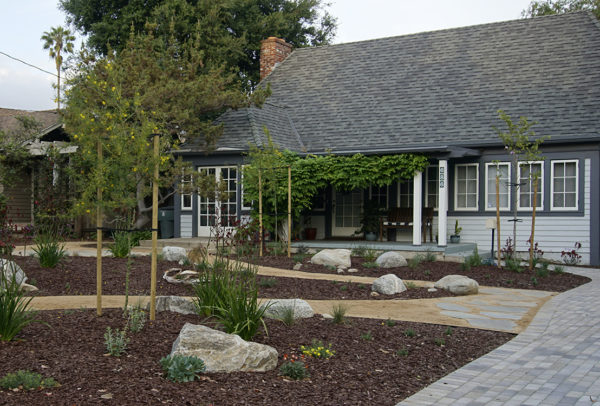
2. Group plants by thirst to save water
When nature is your palette, it might seem like any decision is environmentally-friendly, but some planting decisions are better than others for minimizing your environmental footprint. Cluster plants that have similar water needs together in the same planting beds to protect plants against over- and under-watering. This technique, called “hydrozoning,” significantly reduces water use by making irrigation systems more efficient and avoid over- or under-watering your plants.
Plants that need more water belong in the shadiest areas, near your house, and closest to your water source. Plants in this Zone 1, like lawns, annuals, herbs, and veggies, will need regular irrigation. A moderate Zone 2 is for hardier plants that adapt to moderate shade and less frequent waterings of two to three times per week. Further from the house, group hardy plants like local natives, succulents, sages, and other drought-resistant perennials, in areas that receive more sun and are away from thirsty lawns. These Zone 3 plants can take light watering throughout the year and will need a bit more attention in summer months.
Visit local nurseries to select native and adapted species whenever possible, and try to curb high-maintenance annuals, no matter how tempting the flat of petunias look in early spring. Limit lawns to active areas of your yard, where kids and pets will play, and replace sod in other areas with a low-mow fescue or swath of groundcover. You’ll save upwards of 90% on your water bill in the process. (Reference: http://yourenergysavings.gov.au/guides/outdoor-living?items_per_page=1&page=3) Watering plants in the morning or evening will also reduce water use by preventing mid-day evaporation.
If in doubt, just add more plants. Leafy foliage creates biomass that improves air quality by absorbing pollutants and releasing oxygen, minimizing the “heat island effect” of paved areas, prevent erosion, and filter water as it moves through the soil to underground aquifers.
Save even more water by sprucing up your irrigation system. Swapping spray irrigation heads for low-emitting lines can save 50% in water bills, and upwards of 24 or more gallons per day. (Reference: http://www.seattle.gov/util/EnvironmentConservation/MyLawnGarden/Smart_Watering/index.htm). Upgrade to a “smart” timer, which uses weather data to tell your irrigation system when to start and for how long to run, to use 40% less water.
Take a walk through your yard every six months or so to look for any issues with your irrigation. Stopped up emitters causing water to pond, broken spray heads that shoot errant water, and misaligned spray heads that overspray water onto nearby pavement are common culprits. Even a small leak the size of a pencil tip can waste thousands of gallons of water in a month.
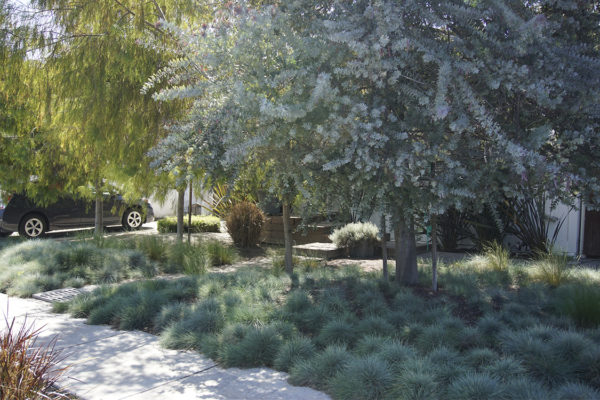
3. Bring in pervious paving to improve water quality
Consider replacing large expanses of concrete, like patios or driveways, with a porous material that allows water to flow through to the soil below. Using pavers or precast units that have gravel or plants in their joints, rather than mortar, allows water to percolate into the soil below. Laying pavers and stone on a sand setting bed rather than a concrete base will accomplish this goal as well.
Decomposed granite, pea gravel, and crushed stone — all available from most home improvements stores — are great alternatives to paved pathways. Decking is another good alternative for gathering areas, thanks to the small gaps between boards. Bonus points for using composite decking made from recycled materials (like Trex) or lumber that the Forest Stewardship Council has labeled FSC-certified. (Reference: https://au.fsc.org/en-au/buy-fsc-certified/certified-timber-from-australia)
An added benefit: because these surfaces let water pass through rather than pool, they’re less likely to buckle or crack over the years. Pervious surfaces are often lower maintenance and become less of a tripping hazard over the years.
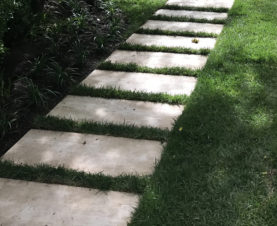
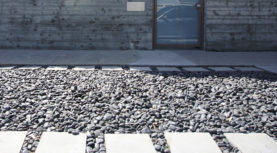
4. Add shade to save on heating and air conditioning
Adding “passive” features that provide more shade in your yard can reduce energy use by 50%. Up to 90% of the heat that reaches your home can be blocked by effective shading.
A pergola or trellis is a great option near an entry to the house bridging indoors and out with dappled shade. Gazebos, arbors, and other garden structures create destinations in the garden while offering some reprieve from the weather.
Planting shade trees has a similar effect. Deciduous trees let light reach your home in the winter, when they lose their leaves, helping to reduce heating bills during chilly months. In the summer, trees like oaks, maples, or birch create a lovely, dappled shade over outdoor living spaces and reduce air conditioning costs. Plant deciduous trees near your house and on the southern side of your property to maximize their benefits. Evergreen conifers can mitigate strong seasonal winds, also insulating your home while casting shade year-round in sunny climates.
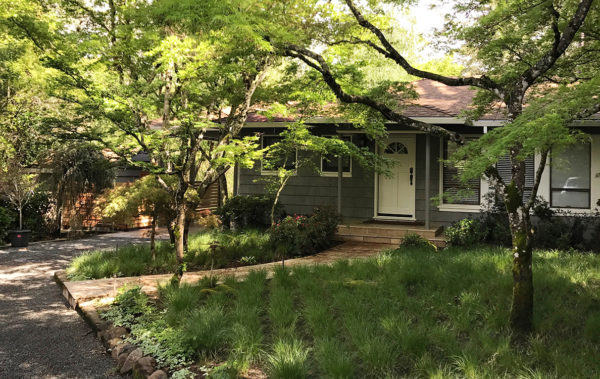
5. Swap landscape lighting fixtures to reduce energy use (and light pollution)
Replacing the incandescent bulbs of older landscape lighting with light-emitting diodes (LED) and solar light fixtures will reduce energy use by 75% and make bulbs last 25 times longer. (Reference: https://energy.gov/energysaver/led-lighting)
Path lights along your entry walk, uplights at the base of a tree or sculpture, spotlights over entryways, and floodlights that washing light on landscape walls are all available in fixtures that have been government-rated for efficiency.
When choosing accent and security light fixtures, try to find some that cast light downwards and emit lower-intensity light, particularly in garden areas that are less frequently travelled. Coupled with light timers or motion sensor lights that come on only as needed, these landscape lighting ideas will significantly minimize light pollution.
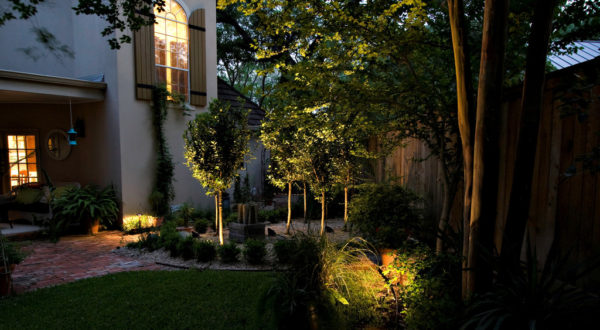
Above all, think quality over quantity. Buying outdoor furniture that will weather well, or natural stone that was sourced from a local quarry, will minimize your environmental footprint while giving you less headaches down the road. Cheaper options quickly add up when they need constant replacement, repainting, and repairs. As you enjoy and care for your yard, you can make plenty of small decisions that make your yard much more sustainable over time.
 Janice Nicol is a licensed landscape architect and founder of YardKit, a landscape design company making landscape renovations easier and more affordable for homeowners. YardKit is great for new homeowners, and is a nice addition to a closing gift ideas or housewarming list.
Janice Nicol is a licensed landscape architect and founder of YardKit, a landscape design company making landscape renovations easier and more affordable for homeowners. YardKit is great for new homeowners, and is a nice addition to a closing gift ideas or housewarming list.
Prior to YardKit, Janice worked for boutique landscape design companies in San Francisco, driving design and construction projects for universities, corporate campuses, and cities, counting Google and Stanford University among her clients.



Hello
Great ideas, ideally native plants would be used to minimize or eliminate the need to irrigate the landscape. Rainwater harvesting is a great way to water the plants without the guilt or negative environmental impact.
Absolutely Michael, both good tips!
Hello Kirsten, you have shared a few ways we can upgrade garden areas to conserve natural resources, saving money and utility bills as a happy by product. This is appreciable post. I just love the way of gardening. Thanks.
Hi Janice, you have shared nice post to enhance the garden. Thanks for posting such useful tips to make garden more elegant. Keep updating us by posting such informative posts.
Hi Janice, thanks for sharing with us all these wonderful ideas in regards to having a sustainable yard that is eco-friendly as well. Really agreeing with you to change the light bulbs with LED’s. Tried them and definitely worth it! Keep up the great work always!
Great tips, so much water is wasted by traditional yards. Love the photos- some great examples.
Find 50% off Latest Cheap High quality Garden designs tools , Outdoor Lightnings, Patio Furniture s ,
More latest designs ideas , new tools find here ,https://www.bestgardendesignshop.com/